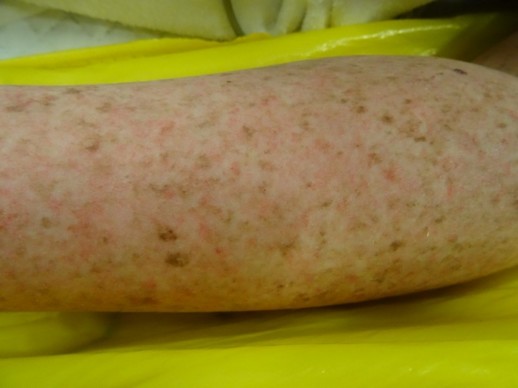Very rare: 1/1.000.000 in Europe, 1/250,000 births in the USA but 1/40.0000 the Japan, the Maghreb and the Middle East.
Autosomal recessive transmission. Eight subgroups corresponding to 8 mutations located on different chromosomes that cause photosensitivity to ultraviolet radiation (U.V.) by deficit of DNA damage repair mechanisms produced by UV.
Without protection from sunlight, these patients have accelerated skin aging and present a major risk of skin cancer.
7 subgroups of the classic form of XP are:
- XPA: severe form with progressive neurological abnormalities that occur around adolescence: deafness, motor incoordination
- XPB: very rare, close to Cockayne syndrome
- XPC: most common form, without neurological problems
- XPD: heterogeneous presentation, more or less important neurological abnormalities
- XPE: rare; few symptoms, no neurological disorders
- XPE: almost exclusively in Japan
- XPG: very rare, close to Cockayne's syndrome.
The 8th form, known as XPV for 'variant', where the signs of intolerance to sunlight and skin cancers appear in the second decade.
In the first months of life (except XPV): severe redness after even minimal exposure to the sunlight. Appearance of many ephelides (freckles spots) on the face and neck. Fine, dry and very pigmented skin where it is exposed to the sunlight. in case of repeated expositions to the sunlight: small rough red spots (solar keratoses as in elderly people).

Very early onset of basal cell or squamous cell skin cancers and melanoma.
Early involvement of the conjunctivae with photophobia, sometimes blepharospasm
Treatment: avoiding exposure to daylight ("children of the Moon"). Otherwise, cover the maximum of skin with tissue, use protective creams (index + 50, to be repeated every 2 h), wear sunglasses. Some neon and halogen bulbs also produce UV .
Anesthetic implications:
skin and eyes protection from any UV sources: for the UV, an exposition superior to 10µW/cm2 should be avoided. To protect from an excessive exposition to UV, a special film (DermogardTM) can be placed between the light source and the skin. Possible airway problems induced by skin atrophy or retractile scars. Difficult peripheral venous access . Induction and emergence of anesthesia in dim light (photophobia). Avoid Xrays. Some recommend avoidance of halogenated agents that are known to increase DNA damage in lymphocytes in vitro, but patients have been anesthetized with sevoflurane without evident problem.
References :
- Brünner T, Jöhr M.
Anesthetic management of a child with xeroderma pigmentosum.
Pediatr Anesth 2004; 14: 697-8.
- Oliveira CRD, Elias L, Barros,ACdM, Conceicao DB.
Anesthesia in patient with Xeroderma Pigmentosum : case report.
Rev Bras Anesthesiol 2003 ; 53 : 46-51.
- Lehmann AR.
Xeroderma pigmentosum.
Orphanet J Rare Diseases 2011 ; 6 :70.
- Zarroudi Y, Makoudi M, Ziadi A, Elamrani D, Ettabli D, Samkaoui MA.
Anesthesia for patients with xeroderma pigmentosum : a twelve consecutive patients case series.
J Clin Anesth 2017 ; 42 : 13-4.
- Bates J, Hall A, Kunanandam T, Hewitt R.
Otological surgery in paediatric photosensitive patients.
Int J Pediar Otorhinolaryngol 2018; 115: 175-6.
Updated: October 2021